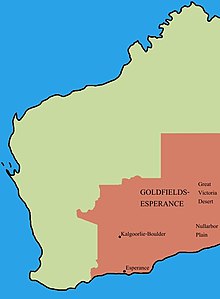Goldfields–Esperance

The Goldfields-Esperance region is one of the nine regions of Western Australia. It is located in the south eastern corner of Western Australia, and comprises the local government areas of Coolgardie, Dundas, Esperance, Kalgoorlie-Boulder, Laverton, Leonora, Menzies, Ngaanyatjarraku and Ravensthorpe.
It also incorporates that area along the Great Australian Bight to the South Australian border known as the Nullarbor.
The Goldfields-Esperance region is the largest of Western Australia's regions, with an area of 771,276 km². It is mostly a low and flat plateau of extremely ancient Precambrian rocks which have been stable since long before the Paleozoic. Because of the extreme geological stability and the absence of glaciation since the Carboniferous, the soils are extremely infertile and generally quite saline. Consequently, the region supports the lowest stocking rates in the world: it is considered that one sheep per square mile is the maximum sustainable rate except in the small wetter area near Esperance. There are no rivers: any rainfall that is not absorbed by the dense rooting systems of the native flora percolates to form extremely saline groundwater which is very frequently too salty even for adult sheep.
The climate is mostly hot and dry. Annual rainfall is typically around 250mm (10 inches) per year and can be very variable, except in the small area near Esperance and Cape Arid National Park where reliable winter rainfall can give annual totals as high as 635mm (25 inches) falling mainly in the winter months. Most rainfall is produced by thunderstorms in spring or summer or by cloudbands from the northwest in autumn and winter, but sometimes cyclones from the Pilbara decay into rain depressions and produce heavy rainfall. Climate change has already had a major impact[citation needed]: in the Kalgoorlie - Eucla - Wiluna - Giles area annual rainfall has increased by over 40 percent since 1967 - probably due to lower frequencies of anticyclones located over the interior of Australia instead of the adjacent oceans.
It has a population of about 59,000 people, about half of whom live in the City of Kalgoorlie-Boulder. Another quarter live in the Shire of Esperance, and the remaining shires are very sparsely populated. Nearly 10% of the region's population are of Aboriginal descent, which is substantially higher than the state as a whole.
The economy of the Goldfields sub-region is based on the extraction and processing of various mineral resources, primarily gold and nickel. Further south near Esperance, the economy is based on agriculture and fishing, with wheat and barley widely grown; however, this requires huge inputs in fertilisers because of the sandy nature of the soils and is a major threat to the region's great plant diversity.
